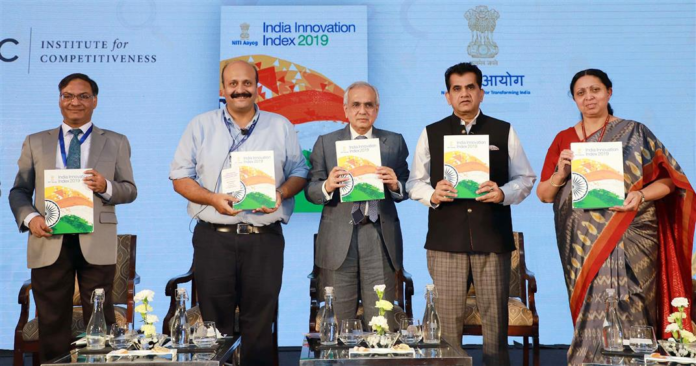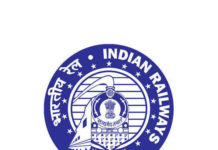New Delhi (NVI): Taking cues from Global Innovation Index, India has launched its own innovation index, mapping the innovation landscape of all its 29 states and seven Union Territories. The first such official index was released recently wherein Karnataka, Tamil Nadu, Maharashtra, Telangana and Haryana ranked as top five states.
The NITI Aayog has partnered with Institute for Competitiveness to come out with the maiden India Innovation Index (III) 2019. The Index was released by Aayog’s Vice Chairman Dr. Rajiv Kumar and CEO Amitabh Kant.
Chattisgarh, Bihar and Jharkhand are at the bottom of the index among states. Among north-eastern states, Sikkim, Himachal Pradesh and Uttarakhand have top the index while Delhi, Chandigarh and Goa have topped the list among union territories in the countries.
The idea behind the index, which has been developed over last one-and-a-half year, is to analyse innovation at state level. The index ranks the states based on their innovation capability, the challenges and opportunities that lie for states and actions needed by policy makers to foster innovation.
The index is based on seven pillars which include five enablers and two performance indicators some of which include human capital, investment, knowledge workers and knowledge output.
“Philosophy of naming and shaming states will help them to innovate,” NITI Aayog CEO Amitabh Kant said.
It may be noted that India has improved its ranking in the global innovation index by five places to 52nd in 2019 from 57th position last year.
Dr. Rajiv Kumar expressed hope that “the India Innovation Index would create synergies between different stakeholders in the innovation ecosystem and India would shift to competitive good governance.” Shri Amitabh Kant added that “India has a unique opportunity among its myriad challenges to become the innovation leader in the world.”
| States | III Rank | Enablers Rank | Performance Rank |
| Major States | |||
| KARNATAKA | 1 | 3 | 1 |
| TAMIL NADU | 2 | 5 | 2 |
| MAHARASHTRA | 3 | 1 | 3 |
| TELANGANA | 4 | 9 | 4 |
| HARYANA | 5 | 2 | 7 |
| KERALA | 6 | 4 | 8 |
| UTTAR PRADESH | 7 | 15 | 5 |
| WEST BENGAL | 8 | 11 | 6 |
| GUJARAT | 9 | 6 | 9 |
| ANDHRA PRADESH | 10 | 8 | 10 |
| PUNJAB | 11 | 7 | 13 |
| ODISHA | 12 | 10 | 11 |
| RAJASTHAN | 13 | 12 | 12 |
| MADHYA PRADESH | 14 | 13 | 14 |
| CHHATTISGARH | 15 | 14 | 17 |
| BIHAR | 16 | 16 | 15 |
| JHARKHAND | 17 | 17 | 16 |
| NE and Hill states | |||
| SIKKIM | 1 | 1 | 11 |
| HIMACHAL PRADESH | 2 | 2 | 5 |
| UTTARAKHAND | 3 | 4 | 1 |
| MANIPUR | 4 | 3 | 4 |
| JAMMU & KASHMIR | 5 | 5 | 3 |
| TRIPURA | 6 | 6 | 9 |
| ARUNACHAL PRADESH | 7 | 7 | 6 |
| ASSAM | 8 | 11 | 2 |
| NAGALAND | 9 | 9 | 7 |
| MIZORAM | 10 | 8 | 10 |
| MEGHALAYA | 11 | 10 | 8 |
| Union Territories/City states/Small States
|
|||
| DELHI | 1 | 3 | 1 |
| CHANDIGARH | 2 | 2 | 2 |
| GOA | 3 | 1 | 5 |
| PUDUCHERRY | 4 | 5 | 6 |
| ANDAMAN & NICOBAR ISLANDS | 5 | 4 | 7 |
| DAMAN & DIU | 6 | 7 | 3 |
| DADRA & NAGAR HAVELI | 7 | 8 | 4 |
| LAKSHADWEEP | 8 | 6 | 8 |
The study examines the innovation ecosystem of Indian states and union territories. The aim is to create a holistic tool which can be used by policymakers across the country to identify the challenges to be addressed and strengths to build on when designing the economic growth policies for their regions. The states have been bifurcated into three categories: major states, north-east, and hill states, and union territories/city states/small states.
Recognizing the role of innovation as a key driver of growth and prosperity for India, NITI Aayog with Institute for Competitiveness as the knowledge partner has released the India Innovation Index 2019. The study is an outcome of extensive research and analysis, which looks holistically at the innovation landscape of India by examining the innovation capabilities and performance of Indian states and union territories. The aim is to create a holistic tool which can be used by policymakers across the country to identify the challenges to be addressed and strengths to build on when designing the economic growth policies for their regions.
The index attempts to create an extensive framework for the continual evaluation of the innovation environment of 29 states and seven union territories in India and intends to undertake the ranking of states and UTs based on their index scores, recognise opportunities and challenges, and assist in tailoring governmental policies to foster innovation.
The India Innovation Index 2019 is calculated as the average of the scores of its two dimensions – Enablers and Performance. The Enablers are the factors that underpin innovative capacities, grouped in five pillars: (1) Human Capital, (2) Investment, (3) Knowledge Workers, (4) Business Environment, and (5) Safety and Legal Environment. The Performance dimension captures benefits that a nation derives from the inputs, divided in two pillars: (6) Knowledge Output and (7) Knowledge Diffusion.
The index presents the latest findings and highlights the regional catalysts and caveats for promoting innovation readiness. The Report offers a comprehensive snapshot of the innovation ecosystem of 29 states and seven union territories. It also includes a section on state profiles covering 33 indicators looking at the different facets of innovation in India.
The index shows that the innovation ecosystem of the country is strong in south and western parts of India. In fact, three of the top five major states are from southern India. Delhi and Haryana seem to be an exception to this rule and seem to be doing well on the Index. Thus, there seems to be a west-south and north-east divide across the country.
The states have been bifurcated into three categories: major states, north-east and hill states, and union territories / city states / small states. Karnataka is the leader in the overall rankings in the category of major states. Karnataka’s number one position in the overall ranking is partly attributed to its top rank in the Performance dimension. It is also among the top performers in Infrastructure, Knowledge Workers, Knowledge Output and Business Environment.
Among the category of major states, Maharashtra performs the best in the dimension of Enablers. This implies that it has the best enabling environment for innovation, even though the state comes in at the third position in the overall innovation index.
The broad level learnings and some policy imperatives at the national level include increasing the spending on research and development, improving the capability of top rung educational institutions in the country to produce greater innovation outputs. There is also a need for greater coordination and collaboration between the industry and educational institutions for enhancing innovation capability. A collaborative platform consisting of all the stakeholders of innovation – innovators, researchers, and investors from the industry should be developed. This will help in strengthening the industry-academia linkages and will ease the process of technology transfer by providing a platform for innovators to showcase their inventions.
At the state level, broad level key learning includes forming policies at the state level that seek to improve the innovation and entrepreneurial ecosystem. Cluster development programs are also an area in need of greater coordination and can benefit from a more open collaborative approach. Also, the industrial policies at the state level should focus more on innovation. At present only a few policies exist for innovation even in the most innovative states and union territories.
-nad











